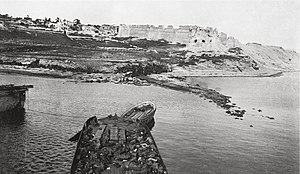Landing at Cape Helles
| Landing at Cape Helles | |||||||
|---|---|---|---|---|---|---|---|
| Part of the Gallipoli Campaign | |||||||
 Sedd-el-Bahr fort seen from the bow of the SS River Clyde during the landing at V Beach |
|||||||
|
|||||||
| Belligerents | |||||||
|
|
|
||||||
| Commanders and leaders | |||||||
| Aylmer Hunter-Weston |
Halil Sami Bey Mahmut Sabri Bey |
||||||
| Strength | |||||||
| 12 battalions | 1 battalion (initial) 1 regiment (total) |
||||||
| Casualties and losses | |||||||
| 6,500 killed and wounded | 1,898 killed, wounded and prisoner | ||||||
Coordinates: 40°02′35″N 26°10′31″E / 40.0431°N 26.1753°E
The landing at Cape Helles (Turkish: Seddülbahir Çıkarması) was part of the amphibious invasion of the Gallipoli peninsula by British and French forces on 25 April 1915 during the First World War. Helles, at the foot of the peninsula, was the main landing area. With the support of the guns of the Royal Navy, the 29th Division was to advance six miles (9.7 km) along the peninsula on the first day and seize the heights of Achi Baba. The British were then to go on to capture the forts that guarded the straits of the Dardanelles. A feigned landing at Bulair by the Royal Naval Division and a real landing at Anzac Cove were made to the north at Gaba Tepe, by the Australian and New Zealand Army Corps before dawn and a diversionary landing was made by French forces at Kum Kale on the Asiatic shore of the Straits. After dark another demonstration was made by the French in Besika Bay.
The Helles landing was mismanaged by the British commander, Major General Aylmer Hunter-Weston. V and W beaches became bloodbaths, despite the meagre defences, while the landings at other sites were not exploited. Although the British managed to gain a foothold ashore, their plans were in disarray. For two months the British fought several costly battles to reach the first day objectives but were defeated by the Ottoman army.
...
Wikipedia
